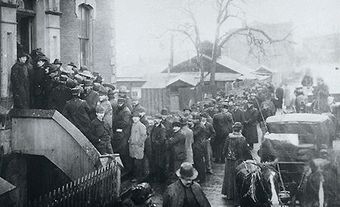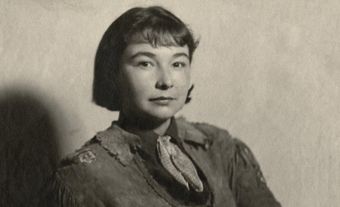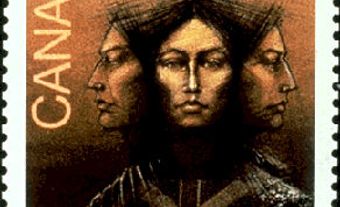Shaaw Tláa (a.k.a Kate Carmack), (born c. 1857-1867 near present-day Bennett Lake, YT; died 29 March 1920 in Carcross, YT). A Tagish woman, Shaaw Tláa (pronounced Shaw Claw) was part of the group that discovered gold near the Klondike River in 1896, sparking the Klondike Gold Rush. She and her husband George Carmack, a white American, had spent a decade in search of gold in the Yukon. They made $1 million from their gold claim; however, George later abandoned her and she was unsuccessful in suing for her half of the fortune.

Early Life
Shaaw Tláa was born between 1857 and 1867, near the Bennett Lake area, along the present-day British Columbia and Yukon border. She was of the dakl’aweidí (killer whale) clan. Her mother was Gus’dutéen, a member of the Tagish wolf clan and her father was Kaachgaawáa, head of the Tlingit crow clan. One of eight children, Shaaw Tláa grew up in the south-central Yukon area. The family spent the seasons moving around, living off and being stewards of the land.
Shaaw Tláa’s first husband was Kult’ús, a Tlingit cousin. They lived in a village called Lkoot, on the coast and near present-day Haines, Alaska. Kult’ús and their infant daughter died in an influenza epidemic in Alaska around 1886. After their deaths, Shaaw Tláa returned to her Tagish family. There she met George Carmack, a white American. George had deserted the US Marines and tried his hand at ranching and sheep herding before travelling to Alaska to take up prospecting. He married Shaaw Tláa’s niece or sister, but his wife died within a few months of their marriage. As was Tlingit practice, her family encouraged a quick remarriage and Shaaw Tláa and George married in 1886 or 1887. However, there was no legal record of their marriage, which caused difficulties for Shaaw Tláa later in her life. George gave Shaaw Tláa the English name Kate.

Prospecting
In 1899, George and Shaaw Tláa set off in search of gold. For the first decade of their marriage, the couple moved around the Forty Mile district in the Yukon, hunting, trapping, trading, and placer mining (looking for gold in creeks and riverbeds). Their daughter Aagé (Graphie Grace), was born 11 January 1893 in Fort Selkirk. Shaaw Tláa had learned skills from her Tagish and Tlingit female relatives that helped them survive. To provide for her family, she sewed and sold winter apparel to miners, as well as hunted game, fished, and gathered food.

Discovering Gold and the Klondike Gold Rush
In 1896, Shaw Tláa’s brother, Keish (also spelled Kèsh, also known as Skookum Jim) and her nephew, Káa Goox (also known as Dawson Charlie) came to find the couple, whom they had not heard from for a few years. On 17 August 1896, the group discovered gold in Rabbit Creek (later renamed Bonanza Creek), a tributary of the Klondike River. Various versions of the discovery story circulated, which attributed the discovery to different members of the group.
Regardless of the exact nature of the discovery, George staked the first claim, and was followed by Keish and Káa Goox. The discovery sparked the Klondike Gold Rush, which brought 30,000 stampeders to the area and led to the establishment of permanent settlements, such as Dawson City. It was a significant event in the history of the Yukon and led to the territory joining Confederation (see Yukon and Confederation).
The group wasn’t able to collect on their riches immediately and spent a difficult winter on the Klondike. To survive, Shaaw Tláa continued to sell items to miners and to trap and gather food. They spent two seasons working their claim and found $1 million in gold. Shaaw Tláa told stories of their floors being covered in gold nuggets during the Gold Rush and she owned gold nugget-adorned jewelry.

Post-Gold Rush in America
In 1898, the Klondike discoverers traveled to Seattle with their newfound riches. George flashed his wealth around and one newspaper reported the group tossing coins from their hotel room to passersby on the street below. This was the first time that Shaaw Tláa had been outside of the North. From Seattle, the family travelled to San Francisco and then further south in California to stay with George’s sister. On a return trip to Dawson City, George met and fell in love with Marguerite Laimee, a brothel owner. George claimed the he and Shaaw Tláa were never legally married and he married Marguerite in October 1900.
Shaaw Tláa sued George for divorce on the grounds of desertion and adultery. She asked for half of their properties, which included their Klondike claims and property in America. The suit was not successful and Shaaw Tláa never received her share of their fortune. However, after Shaaw Tláa’s death, a judge ruled that her and George’s marriage had been valid in a lawsuit brought by their daughter Aagé (Graphie Grace) and George’s sister Rose.

Later Life and Legacy
Shaw Tláa and her daughter Aagé (Graphie Grace) returned to the Yukon around 1900 and lived with the Tagish Nation in Carcross. In 1909, Aagé left to live with George in the United States and Shaaw Tláa never saw her daughter again. She lived the rest of her life in a cabin in Carcross that Keish had built for her. She subsisted on a government pension and sold needlework to tourists. Shaaw Tláa died on 29 March 1920 in Carcross in an influenza epidemic.
For many years, Shaaw Tláa’s role in the Klondike Gold Rush was largely overlooked. As she was not able to read or write, her story has been told through oral history and by studying the written records of others. Nevertheless, she played an important role in an event that shaped the history of the Yukon and Canada.
Shaaw Tláa was inducted into the Canadian Mining Hall of Fame in 2019, 20 years after the other Klondike discoverers were inducted. In 2021, the Royal Canadian Mint released a commemorative loonie for the 125th anniversary of the Klondike Gold Rush, featuring Shaaw Tláa and the other discoverers.

 Share on Facebook
Share on Facebook Share on X
Share on X Share by Email
Share by Email Share on Google Classroom
Share on Google Classroom



